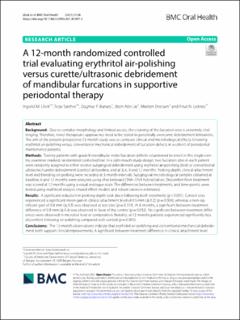| dc.description.abstract | Background
Due to complex morphology and limited access, the cleaning of the furcation area is extremely challenging. Therefore, novel therapeutic approaches need to be tested to potentially overcome debridement limitations. The aim of the present prospective 12-month study was to compare clinical and microbiological effects following erythritol air-polishing versus conventional mechanical debridement of furcation defects in a cohort of periodontal maintenance patients.
Methods
Twenty patients with grade II mandibular molar furcation defects volunteered to enroll in this single-centre, examiner masked, randomized controlled trial. In a split-mouth study design, two furcation sites in each patient were randomly assigned to either receive subgingival debridement using erythritol air-polishing (test) or conventional ultrasonic/curette debridement (control) at baseline, and at 3, 6, 9 and 12 months. Probing depth, clinical attachment level and bleeding on probing were recorded at 3-month intervals. Subgingival microbiological samples obtained at baseline, 6 and 12 months were analyzed using checkerboard DNA–DNA hybridization. Discomfort from treatment was scored at 12 months using a visual analogue scale. The differences between treatments, and time-points, were tested using multilevel analysis (mixed effect models and robust variance estimates).
Results
A significant reduction in probing depth took place following both treatments (p < 0.001). Control sites experienced a significant mean gain in clinical attachment level of 0.5 mm (± 0.2) (p = 0.004), whereas a non-significant gain of 0.4 mm (± 0.3) was observed at test sites (p = 0.119). At 6 months, a significant between-treatment difference of 0.8 mm (± 0.4) was observed in favor of the control (p = 0.032). No significant between-treatment differences were observed in microbial load or composition. Notably, at 12 months patients experienced significantly less discomfort following air-polishing compared with control (p = 0.001).
Conclusions
The 12-month observations indicate that erythritol air-polishing and conventional mechanical debridement both support clinical improvements. A significant between-treatment difference in clinical attachment level was, however, detected in favour of control debridement at 6 months. In terms of patient comfort, erythritol air-polishing is superior. | en_US |

